Abstract
Exposure to phospholipase C increased the incorporation of [32P]Pi into phosphatidate, CMP-phosphatidate and phosphatidylinositol in rat adipose tissue and isolated adipocytes. A similar effect was observed in response to insulin and oxytocin. Theophylline, 3-isobutyl-1-methylxanthine and adenosine deaminase decreased [32P]Pi incorporation, and adenosine and N6-phenylisopropyladenosine reversed these effects. As with insulin, exposure of adipose tissue to phospholipase C stimulated oxidation of glucose, pyruvate and leucine and activated pyruvate dehydrogenase. Oxytocin and adenosine also mimicked the effects of insulin on leucine oxidation and pyruvate dehydrogenase. However, only insulin stimulated glycogen synthase activity, indicating that the regulation of synthase may be achieved by intracellular events distinct from those regulating changes in phospholipid metabolism, sugar transport and mitochondrial enzyme activities. It is postulated that exposure to phospholipase C forms diacylglycerol, which is phosphorylated to yield phosphatidate. The increased labelling of CMP-phosphatidate and phosphatidylinositol results from the conversion of phosphatidate into these lipids. The correlation between the effects of phospholipase C on phosphatidate synthesis and changes in adipose-tissue metabolism suggests the possibility that increased phosphatidate may directly or indirectly produce changes in membrane transport and enzyme activities. The pattern of phospholipid labelling produced by insulin, adenosine and oxytocin suggests that these stimuli may also increase phosphatidate synthesis, and, if so, changes in phospholipid metabolism could account for some of the metabolic actions of these stimuli.
Full text
PDF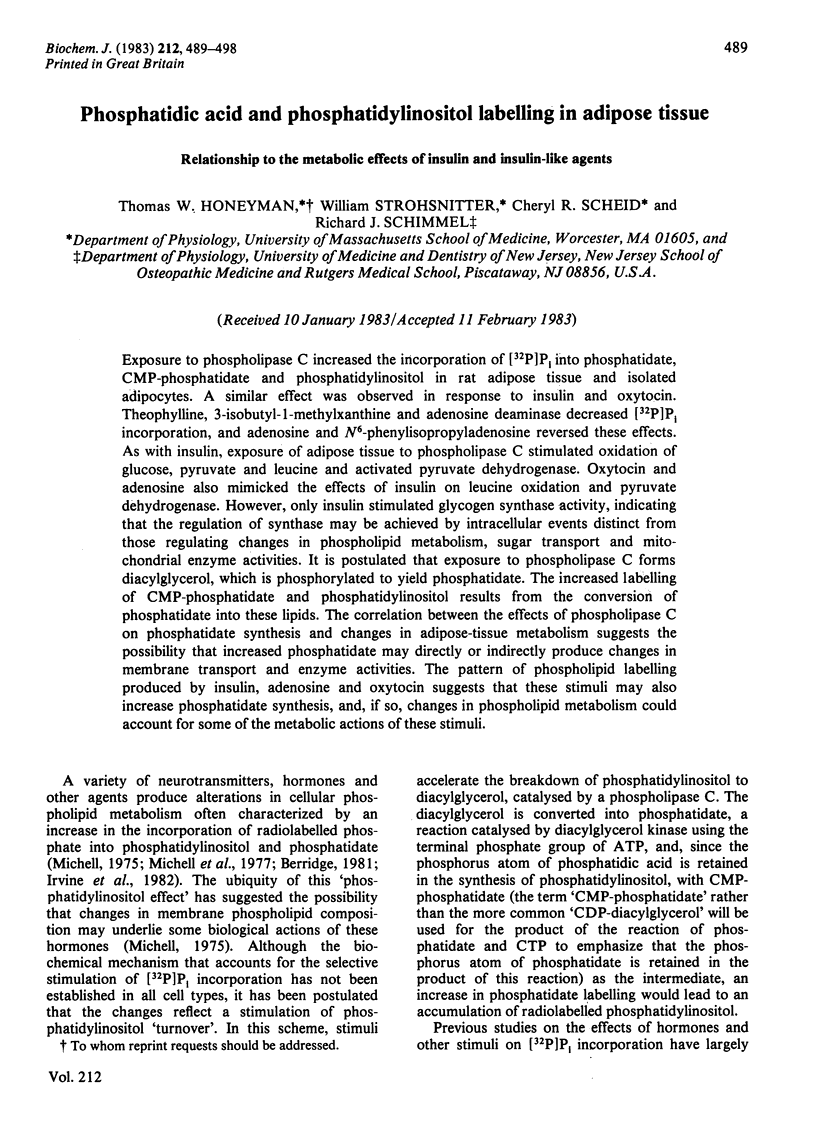

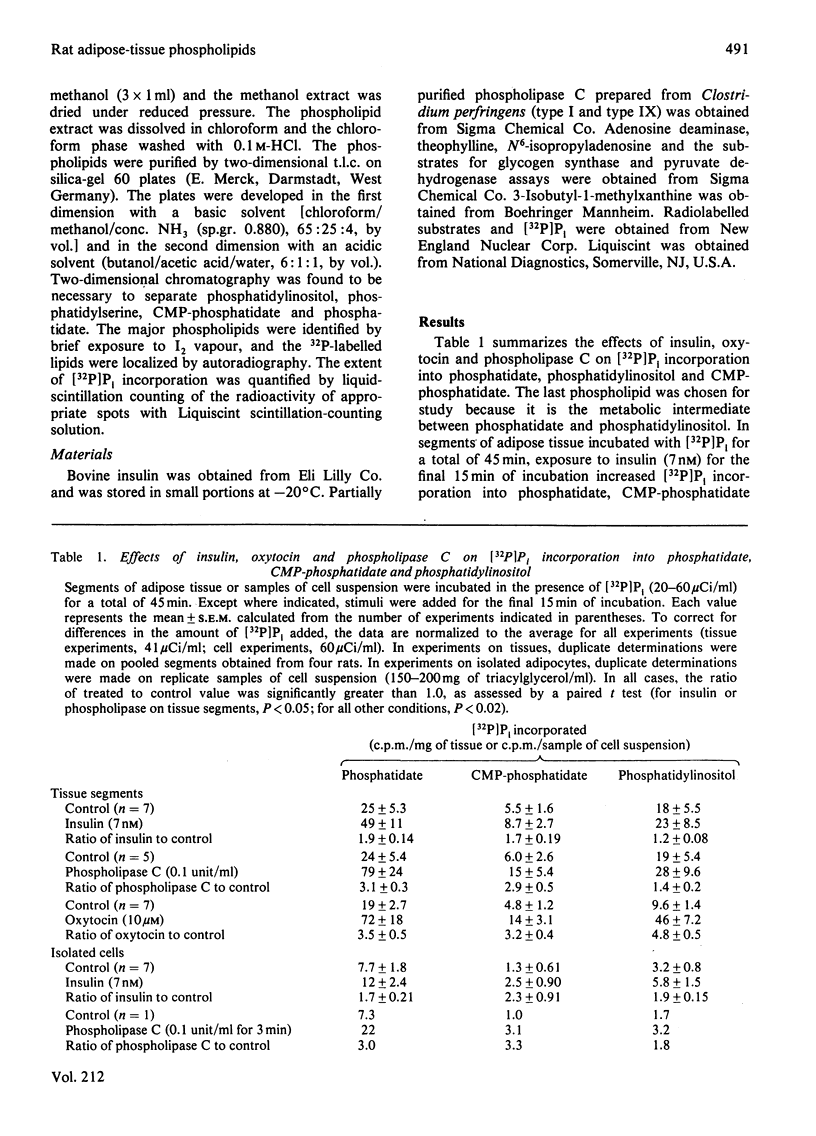
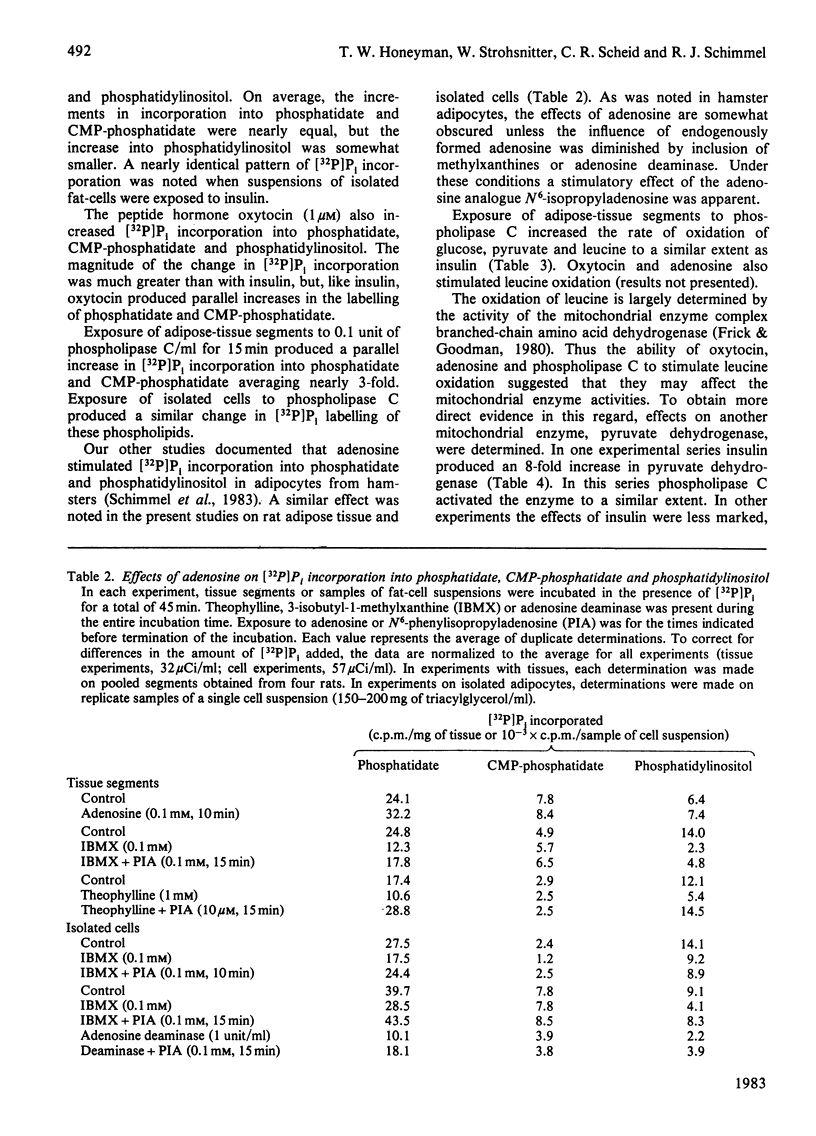

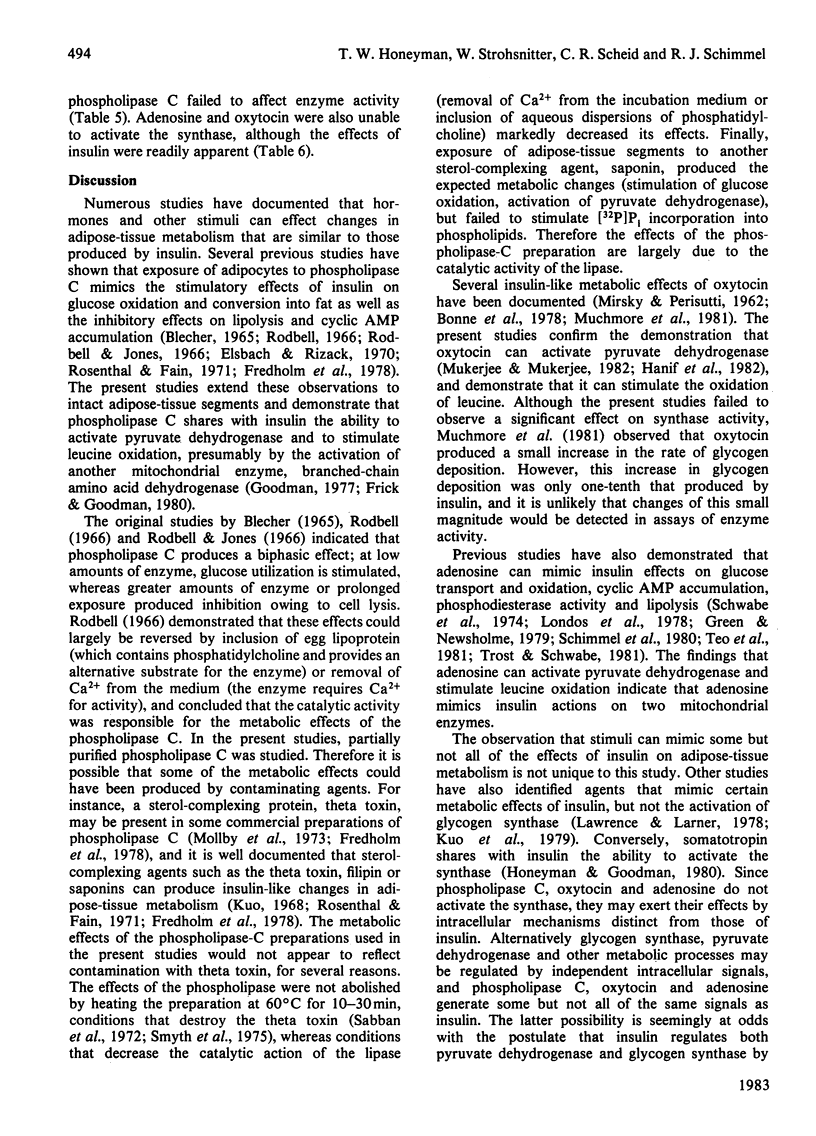
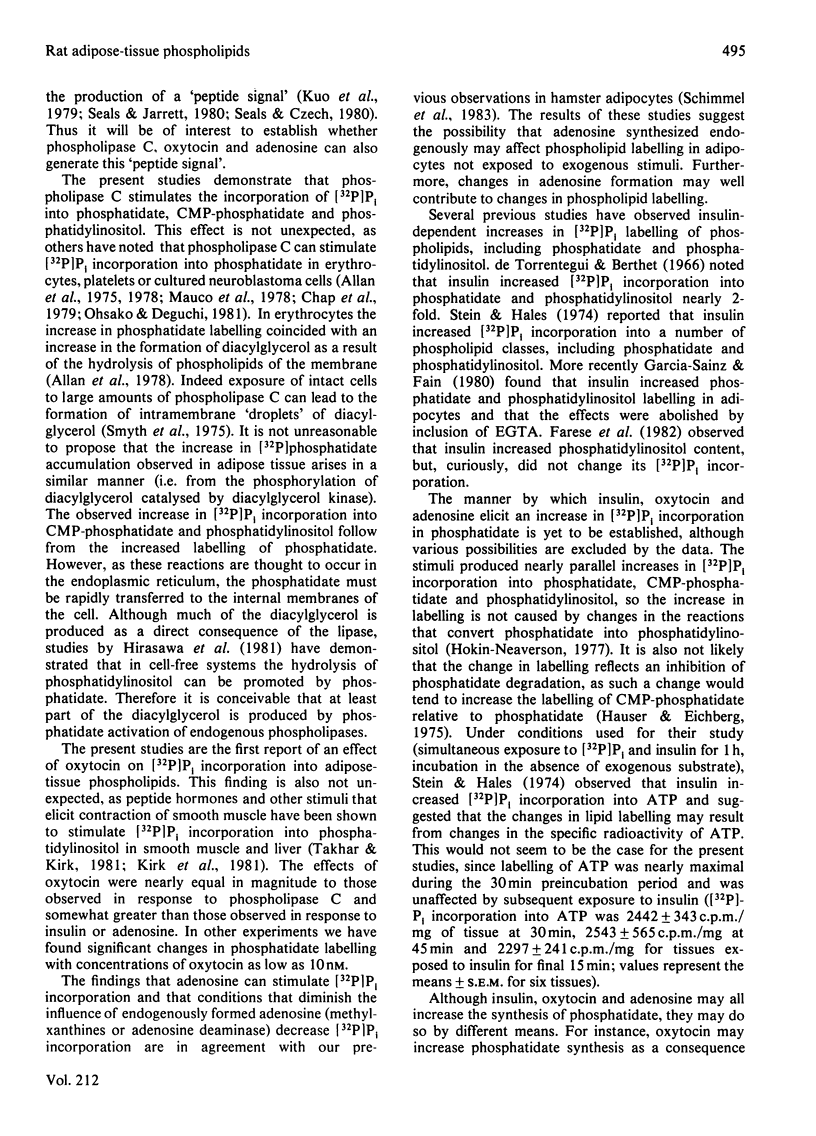
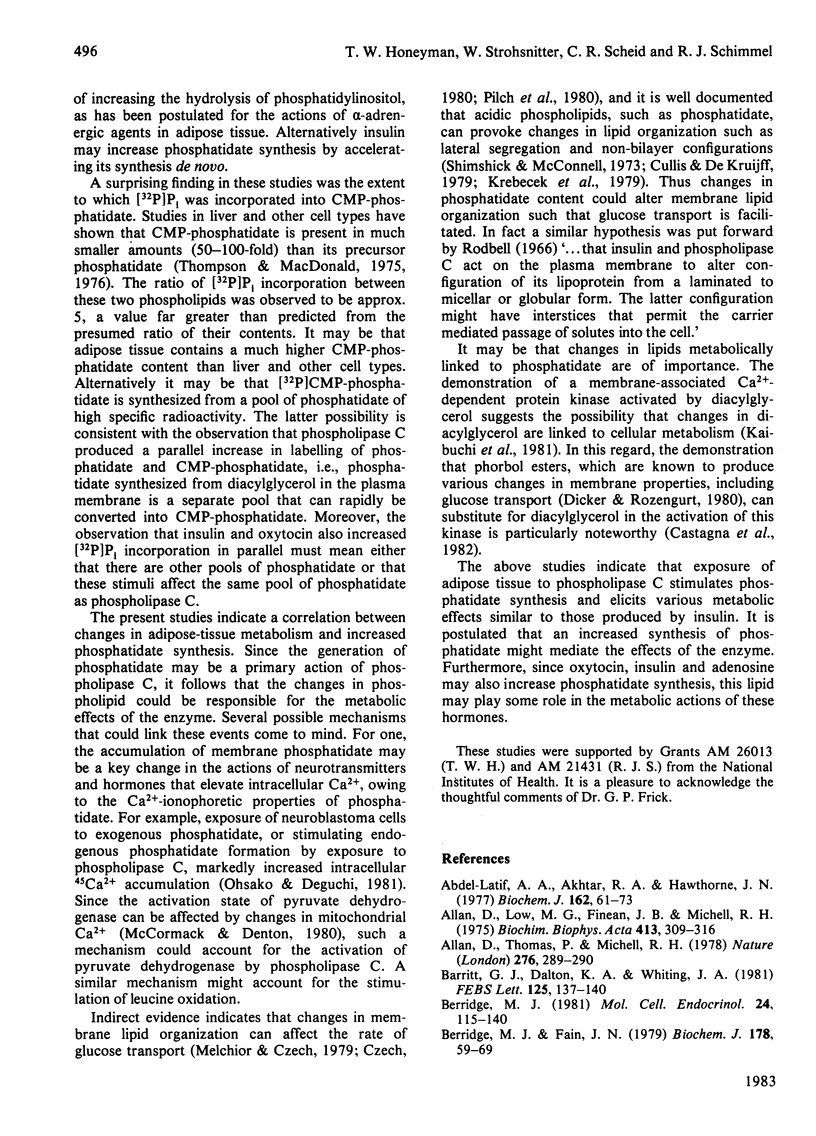
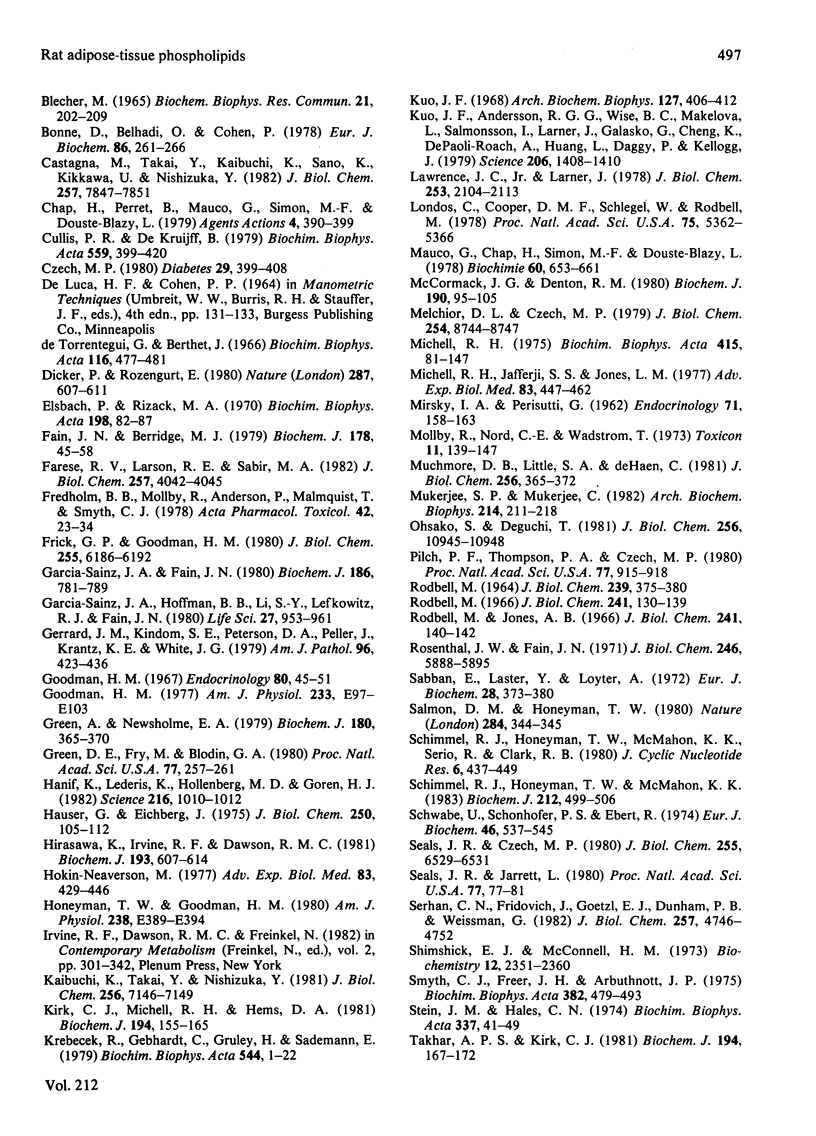

Selected References
These references are in PubMed. This may not be the complete list of references from this article.
- Abdel-Latif A. A., Akhtar R. A., Hawthorne J. N. Acetylcholine increases the breakdown of triphosphoinositide of rabbit iris muscle prelabelled with [32P] phosphate. Biochem J. 1977 Jan 15;162(1):61–73. doi: 10.1042/bj1620061. [DOI] [PMC free article] [PubMed] [Google Scholar]
- Allan D., Low M. G., Finean J. B., Michell R. H. Changes in lipid metabolism and cell morphology following attack by phospholipase C (Clostridium perfringens) on red cells or lymphocytes. Biochim Biophys Acta. 1975 Dec 1;413(2):309–316. doi: 10.1016/0005-2736(75)90116-9. [DOI] [PubMed] [Google Scholar]
- Allan D., Thomas P., Michell R. H. Rapid transbilayer diffusion of 1,2-diacylglycerol and its relevance to control of membrane curvature. Nature. 1978 Nov 16;276(5685):289–290. doi: 10.1038/276289a0. [DOI] [PubMed] [Google Scholar]
- Barritt G. J., Dalton K. A., Whiting J. A. Evidence that phosphatidic acid stimulates the uptake of calcium by liver cells but not calcium release from mitochondria. FEBS Lett. 1981 Mar 23;125(2):137–140. doi: 10.1016/0014-5793(81)80703-x. [DOI] [PubMed] [Google Scholar]
- Berridge M. J., Fain J. N. Inhibition of phosphatidylinositol synthesis and the inactivation of calcium entry after prolonged exposure of the blowfly salivary gland to 5-hydroxytryptamine. Biochem J. 1979 Jan 15;178(1):59–69. doi: 10.1042/bj1780059. [DOI] [PMC free article] [PubMed] [Google Scholar]
- Berridge M. J. Phosphatidylinositol hydrolysis: a multifunctional transducing mechanism. Mol Cell Endocrinol. 1981 Nov;24(2):115–140. doi: 10.1016/0303-7207(81)90055-1. [DOI] [PubMed] [Google Scholar]
- Blecher M. Phospholipase C and mechanisms of action of insulin and cortisol on glucose entry into free adipose cells. Biochem Biophys Res Commun. 1965 Nov 8;21(3):202–209. doi: 10.1016/0006-291x(65)90272-x. [DOI] [PubMed] [Google Scholar]
- Bonne D., Belhadj O., Cohen P. Calcium as modulator of the hormonal-receptors-biological-response coupling system. Effects of Ca2+ ions on the insulin activated 2-deoxyglucose transport in rat fat cells. Eur J Biochem. 1978 May;86(1):261–266. doi: 10.1111/j.1432-1033.1978.tb12307.x. [DOI] [PubMed] [Google Scholar]
- Castagna M., Takai Y., Kaibuchi K., Sano K., Kikkawa U., Nishizuka Y. Direct activation of calcium-activated, phospholipid-dependent protein kinase by tumor-promoting phorbol esters. J Biol Chem. 1982 Jul 10;257(13):7847–7851. [PubMed] [Google Scholar]
- Cullis P. R., de Kruijff B. Lipid polymorphism and the functional roles of lipids in biological membranes. Biochim Biophys Acta. 1979 Dec 20;559(4):399–420. doi: 10.1016/0304-4157(79)90012-1. [DOI] [PubMed] [Google Scholar]
- Czech M. P. Insulin action and the regulation of hexose transport. Diabetes. 1980 May;29(5):399–409. doi: 10.2337/diab.29.5.399. [DOI] [PubMed] [Google Scholar]
- De Torrontegui G., Berthet J. The action of insulin on the incorporation of [32P]phosphate in the phospholipids of rat adipose tissue. Biochim Biophys Acta. 1966 Jun 1;116(3):477–481. doi: 10.1016/0005-2760(66)90117-2. [DOI] [PubMed] [Google Scholar]
- Dicker P., Rozengurt E. Phorbol esters and vasopressin stimulate DNA synthesis by a common mechanism. Nature. 1980 Oct 16;287(5783):607–612. doi: 10.1038/287607a0. [DOI] [PubMed] [Google Scholar]
- Elsbach P., Rizack M. A. The effect of collagenase preparations contaminated with phospholipase C activity on adipose tissue lecithin. Biochim Biophys Acta. 1970 Jan 14;198(1):82–87. doi: 10.1016/0005-2744(70)90035-5. [DOI] [PubMed] [Google Scholar]
- Fain J. N., Berridge M. J. Relationship between hormonal activation of phosphatidylinositol hydrolysis, fluid secretion and calcium flux in the blowfly salivary gland. Biochem J. 1979 Jan 15;178(1):45–58. doi: 10.1042/bj1780045. [DOI] [PMC free article] [PubMed] [Google Scholar]
- Farese R. V., Larson R. E., Sabir M. A. Insulin acutely increases phospholipids in the phosphatidate-inositide cycle in rat adipose tissue. J Biol Chem. 1982 Apr 25;257(8):4042–4045. [PubMed] [Google Scholar]
- Freholm B. B., Möllby R., Malmquist T., Smyth C. J. Inhibition of noradrenaline-stimulated lipolysis and cyclic AMP accumulation in isolated rat adipocytes by purified phospholipase C and theta-toxin from Clostridium perfringens. Acta Pharmacol Toxicol (Copenh) 1978 Jan;42(1):23–34. doi: 10.1111/j.1600-0773.1978.tb02167.x. [DOI] [PubMed] [Google Scholar]
- Frick G. P., Goodman H. M. Insulin regulation of branched chain alpha-keto acid dehydrogenase in adipose tissue. J Biol Chem. 1980 Jul 10;255(13):6186–6192. [PubMed] [Google Scholar]
- García-Sáinz J. A., Fain J. N. Effect of insulin, catecholamines and calcium ions on phospholipid metabolism in isolated white fat-cells. Biochem J. 1980 Mar 15;186(3):781–789. doi: 10.1042/bj1860781. [DOI] [PMC free article] [PubMed] [Google Scholar]
- García-Sínz J. A., Hoffman B. B., Li S. Y., Lefkowitz R. J., Fain J. N. Role of alpha 1 adrenoceptors in the turnover of phosphatidylinositol and of alpha 2 adrenoceptors in the regulation of cyclic AMP accumulation in hamster adipocytes. Life Sci. 1980 Sep 15;27(11):953–961. doi: 10.1016/0024-3205(80)90105-8. [DOI] [PubMed] [Google Scholar]
- Gerrard J. M., Kindom S. E., Peterson D. A., Peller J., Krantz K. E., White J. G. Lysophosphatidic acids. Influence on platelet aggregation and intracellular calcium flux. Am J Pathol. 1979 Aug;96(2):423–438. [PMC free article] [PubMed] [Google Scholar]
- Goodman H. M. A comparative study of the effects of insulin and growth hormone on hexose metabolism in adipose tissue. Endocrinology. 1967 Jan;80(1):45–51. doi: 10.1210/endo-80-1-45. [DOI] [PubMed] [Google Scholar]
- Goodman H. M. Site of action of insulin in promoting leucine utilization in adipose tissue. Am J Physiol. 1977 Aug;233(2):E97–103. doi: 10.1152/ajpendo.1977.233.2.E97. [DOI] [PubMed] [Google Scholar]
- Green A., Newsholme E. A. Sensitivity of glucose uptake and lipolysis of white adipocytes of the rat to insulin and effects of some metabolites. Biochem J. 1979 May 15;180(2):365–370. doi: 10.1042/bj1800365. [DOI] [PMC free article] [PubMed] [Google Scholar]
- Green D. E., Fry M., Blondin G. A. Phospholipids as the molecular instruments of ion and solute transport in biological membranes. Proc Natl Acad Sci U S A. 1980 Jan;77(1):257–261. doi: 10.1073/pnas.77.1.257. [DOI] [PMC free article] [PubMed] [Google Scholar]
- Hanif K., Lederis K., Hollenberg M. D., Goren H. J. Inability of oxytocin to activate pyruvate dehydrogenase in the Brattleboro rat. Science. 1982 May 28;216(4549):1010–1012. doi: 10.1126/science.7079746. [DOI] [PubMed] [Google Scholar]
- Hauser G., Eichberg J. Identification of cytidine diphosphate-diglyceride in the pineal gland of the rat and its accumulation in the presence of DL-propranolol. J Biol Chem. 1975 Jan 10;250(1):105–112. [PubMed] [Google Scholar]
- Hirasawa K., Irvine R. F., Dawson R. M. The hydrolysis of phosphatidylinositol monolayers at an air/water interface by the calcium-ion-dependent phosphatidylinositol phosphodiesterase of pig brain. Biochem J. 1981 Feb 1;193(2):607–614. doi: 10.1042/bj1930607. [DOI] [PMC free article] [PubMed] [Google Scholar]
- Hokin-Neaverson M. Metabolism and role of phosphatidylinositol in acetylcholine-stimulated membrane function. Adv Exp Med Biol. 1977;83:429–446. doi: 10.1007/978-1-4684-3276-3_40. [DOI] [PubMed] [Google Scholar]
- Honeyman T. W., Goodman H. M. Effects of growth hormone on glycogen metabolism in adipose tissue of hypophysectomized rats. Am J Physiol. 1980 Apr;238(4):E389–E394. doi: 10.1152/ajpendo.1980.238.4.E389. [DOI] [PubMed] [Google Scholar]
- Kaibuchi K., Takai Y., Nishizuka Y. Cooperative roles of various membrane phospholipids in the activation of calcium-activated, phospholipid-dependent protein kinase. J Biol Chem. 1981 Jul 25;256(14):7146–7149. [PubMed] [Google Scholar]
- Kirk C. J., Michell R. H., Hems D. A. Phosphatidylinositol metabolism in rat hepatocytes stimulated by vasopressin. Biochem J. 1981 Jan 15;194(1):155–165. doi: 10.1042/bj1940155. [DOI] [PMC free article] [PubMed] [Google Scholar]
- Krbecek R., Gebhardt C., Gruler H., Sackmann E. Three dimensional microscopic surface profiles of membranes reconstructed from freeze etching electrol micrographs. Biochim Biophys Acta. 1979 Jun 13;554(1):1–22. doi: 10.1016/0005-2736(79)90002-6. [DOI] [PubMed] [Google Scholar]
- Kuo J. F. Stimulation of glucose utilization and inhibition of lipolysis by polyene antibiotics in isolated adipose cells. Arch Biochem Biophys. 1968 Sep 20;127(1):406–412. doi: 10.1016/0003-9861(68)90243-9. [DOI] [PubMed] [Google Scholar]
- Larner J., Galasko G., Cheng K., DePaoli-Roach A. A., Huang L., Daggy P., Kellogg J. Generation by insulin of a chemical mediator that controls protein phosphorylation and dephosphorylation. Science. 1979 Dec 21;206(4425):1408–1410. doi: 10.1126/science.228395. [DOI] [PubMed] [Google Scholar]
- Lawrence J. C., Jr, Larner J. Activation of glycogen synthase in rat adipocytes by insulin and glucose involves increased glucose transport and phosphorylation. J Biol Chem. 1978 Apr 10;253(7):2104–2113. [PubMed] [Google Scholar]
- Londos C., Cooper D. M., Schlegel W., Rodbell M. Adenosine analogs inhibit adipocyte adenylate cyclase by a GTP-dependent process: basis for actions of adenosine and methylxanthines on cyclic AMP production and lipolysis. Proc Natl Acad Sci U S A. 1978 Nov;75(11):5362–5366. doi: 10.1073/pnas.75.11.5362. [DOI] [PMC free article] [PubMed] [Google Scholar]
- MIRSKY I. A., PERISUTTI G. Action of oxytocin and related peptides on epididymal adipose tissue of the rat. Endocrinology. 1962 Jul;71:158–163. doi: 10.1210/endo-71-1-158. [DOI] [PubMed] [Google Scholar]
- Mauco G., Chap H., Simon M. F., Douste-Blazy L. Phosphatidic and lysophosphatidic acid production in phospholipase C-and thrombin-treated platelets. Possible involvement of a platelet lipase. Biochimie. 1978 Sep 29;60(6-7):653–661. doi: 10.1016/s0300-9084(78)80784-6. [DOI] [PubMed] [Google Scholar]
- McCormack J. G., Denton R. M. Role of calcium ions in the regulation of intramitochondrial metabolism. Properties of the Ca2+-sensitive dehydrogenases within intact uncoupled mitochondria from the white and brown adipose tissue of the rat. Biochem J. 1980 Jul 15;190(1):95–105. doi: 10.1042/bj1900095. [DOI] [PMC free article] [PubMed] [Google Scholar]
- Melchior D. L., Czech M. P. Sensitivity of the adipocyte D-glucose transport system to membrane fluidity in reconstituted vesicles. J Biol Chem. 1979 Sep 25;254(18):8744–8747. [PubMed] [Google Scholar]
- Michell R. H. Inositol phospholipids and cell surface receptor function. Biochim Biophys Acta. 1975 Mar 25;415(1):81–47. doi: 10.1016/0304-4157(75)90017-9. [DOI] [PubMed] [Google Scholar]
- Michell R. H., Jafferji S. S., Jones L. M. The possible involvement of phosphatidylinositol breakdown in the mechanism of stimulus-response coupling at receptors which control cell-surface calcium gates. Adv Exp Med Biol. 1977;83:447–464. doi: 10.1007/978-1-4684-3276-3_41. [DOI] [PubMed] [Google Scholar]
- Muchmore D. B., Little S. A., de Haën C. A dual mechanism of action of ocytocin in rat epididymal fat cells. J Biol Chem. 1981 Jan 10;256(1):365–372. [PubMed] [Google Scholar]
- Mukherjee S. P., Mukherjee C. Stimulation of pyruvate dehydrogenase activity in adipocytes by oxytocin: evidence for mediation of the insulin-like effect by endogenous hydrogen peroxide independent of glucose transport. Arch Biochem Biophys. 1982 Mar;214(1):211–222. doi: 10.1016/0003-9861(82)90024-8. [DOI] [PubMed] [Google Scholar]
- Möllby R., Nord C. E., Wadström T. Biological activities contaminating preparations of phospholipase C ( -toxin) from Clostridium perfringens. Toxicon. 1973 Feb;11(2):139–147. doi: 10.1016/0041-0101(73)90075-5. [DOI] [PubMed] [Google Scholar]
- Ohsako S., Deguchi T. Stimulation of phosphatidic acid of calcium influx and cyclic GMP synthesis in neuroblastoma cells. J Biol Chem. 1981 Nov 10;256(21):10945–10948. [PubMed] [Google Scholar]
- Pilch P. F., Thompson P. A., Czech M. P. Coordinate modulation of D-glucose transport activity and bilayer fluidity in plasma membranes derived from control and insulin-treated adipocytes. Proc Natl Acad Sci U S A. 1980 Feb;77(2):915–918. doi: 10.1073/pnas.77.2.915. [DOI] [PMC free article] [PubMed] [Google Scholar]
- RODBELL M. METABOLISM OF ISOLATED FAT CELLS. I. EFFECTS OF HORMONES ON GLUCOSE METABOLISM AND LIPOLYSIS. J Biol Chem. 1964 Feb;239:375–380. [PubMed] [Google Scholar]
- Rodbell M., Jones A. B. Metabolism of isolated fat cells. 3. The similar inhibitory action of phospholipase C (Clostridium perfringens alpha toxin) and of insulin on lipolysis stimulated by lipolytic hormones and theophylline. J Biol Chem. 1966 Jan 10;241(1):140–142. [PubMed] [Google Scholar]
- Rodbell M. Metabolism of isolated fat cells. II. The similar effects of phospholipase C (Clostridium perfringens alpha toxin) and of insulin on glucose and amino acid metabolism. J Biol Chem. 1966 Jan 10;241(1):130–139. [PubMed] [Google Scholar]
- Rosenthal J. W., Fain J. N. Insulin-like effect of clostridial phospholipase C, neuraminidase, and other bacterial factors on brown fat cells. J Biol Chem. 1971 Oct 10;246(19):5888–5895. [PubMed] [Google Scholar]
- Sabban E., Laster Y., Loyter A. Resolution of the hemolytic and the hydrolytic activities of phospholipase-C preparation from Clostridium perfringens. Eur J Biochem. 1972 Jul 24;28(3):373–380. doi: 10.1111/j.1432-1033.1972.tb01923.x. [DOI] [PubMed] [Google Scholar]
- Salmon D. M., Honeyman T. W. Proposed mechanism of cholinergic action in smooth muscle. Nature. 1980 Mar 27;284(5754):344–345. doi: 10.1038/284344a0. [DOI] [PubMed] [Google Scholar]
- Schimmel R. J., Honeyman T. W., McMahon K. K. Phosphatidic acid and phosphatidylinositol labelling in adipose tissue. The role of endogenously formed adenosine. Biochem J. 1983 May 15;212(2):499–506. doi: 10.1042/bj2120499. [DOI] [PMC free article] [PubMed] [Google Scholar]
- Schimmel R. J., Honeyman T. W., McMahon K. K., Serio R., Clark R. B. Inhibition of cyclic AMP accumulation in hamster adipocytes with phosphatidic acid: differences and similarities with alpha adrenergic effects. J Cyclic Nucleotide Res. 1980;6(6):437–449. [PubMed] [Google Scholar]
- Schwabe U., Schönhöfer P. S., Ebert R. Facilitation by adenosine of the action of insulin on the accumulation of adenosine 3':5'-monophosphate, lipolysis, and glucose oxidation in isolated fat cells. Eur J Biochem. 1974 Aug 1;46(3):537–545. doi: 10.1111/j.1432-1033.1974.tb03647.x. [DOI] [PubMed] [Google Scholar]
- Seals J. R., Czech M. P. Evidence that insulin activates an intrinsic plasma membrane protease in generating a secondary chemical mediator. J Biol Chem. 1980 Jul 25;255(14):6529–6531. [PubMed] [Google Scholar]
- Seals J. R., Jarett L. Activation of pyruvate dehydrogenase by direct addition of insulin to an isolated plasma membrane/mitochondria mixture: evidence for generated of insulin's second messenger in a subcellular system. Proc Natl Acad Sci U S A. 1980 Jan;77(1):77–81. doi: 10.1073/pnas.77.1.77. [DOI] [PMC free article] [PubMed] [Google Scholar]
- Serhan C. N., Fridovich J., Goetzl E. J., Dunham P. B., Weissmann G. Leukotriene B4 and phosphatidic acid are calcium ionophores. Studies employing arsenazo III in liposomes. J Biol Chem. 1982 May 10;257(9):4746–4752. [PubMed] [Google Scholar]
- Shimshick E. J., McConnell H. M. Lateral phase separation in phospholipid membranes. Biochemistry. 1973 Jun 5;12(12):2351–2360. doi: 10.1021/bi00736a026. [DOI] [PubMed] [Google Scholar]
- Smyth C. J., Freer J. H., Arbuthnott J. P. Interaction of Clostridium perfringens theta-haemolysin, a contaminant of commercial phospholipase C, with erythrocyte ghost membranes and lipid dispersions. A morphological study. Biochim Biophys Acta. 1975 Apr 8;382(4):479–493. doi: 10.1016/0005-2736(75)90216-3. [DOI] [PubMed] [Google Scholar]
- Stein J. M., Hales C. N. The effect of insulin on 32Pi incorporation into rat fat cell phospholipids. Biochim Biophys Acta. 1974 Jan 23;337(1):41–49. doi: 10.1016/0005-2760(74)90038-1. [DOI] [PubMed] [Google Scholar]
- Takhar A. P., Kirk C. J. Stimulation of inorganic-phosphate incorporation into phosphatidylinositol in rat thoracic aorta mediated through V1-vasopressin receptors. Biochem J. 1981 Jan 15;194(1):167–172. doi: 10.1042/bj1940167. [DOI] [PMC free article] [PubMed] [Google Scholar]
- Taylor S. I., Mukherjee C., Jungas R. L. Studies on the mechanism of activation of adipose tissue pyruvate dehydrogenase by insulin. J Biol Chem. 1973 Jan 10;248(1):73–81. [PubMed] [Google Scholar]
- Teo T. S., Ooi S. O., Wong E. H. Stimulation of rat fat cell phosphodiesterase by adenosine. FEBS Lett. 1981 Jun 1;128(1):75–78. doi: 10.1016/0014-5793(81)81083-6. [DOI] [PubMed] [Google Scholar]
- Thomas J. A., Schlender K. K., Larner J. A rapid filter paper assay for UDPglucose-glycogen glucosyltransferase, including an improved biosynthesis of UDP-14C-glucose. Anal Biochem. 1968 Oct 24;25(1):486–499. doi: 10.1016/0003-2697(68)90127-9. [DOI] [PubMed] [Google Scholar]
- Thompson W., MacDonald G. Cytidine diphosphate diglyceride of bovine brain. Positional distribution of fatty acids and analysis of major molecular species. Eur J Biochem. 1976 May 17;65(1):107–111. doi: 10.1111/j.1432-1033.1976.tb10394.x. [DOI] [PubMed] [Google Scholar]
- Thompson W., MacDonald G. Isolation and characterization of cytidine diphosphate diglyceride from beef liver. J Biol Chem. 1975 Sep 10;250(17):6779–6785. [PubMed] [Google Scholar]
- Trost T., Schwabe U. Adenosine receptors in fat cells. Identification by (-)-N6-[3H]phenylisopropyladenosine binding. Mol Pharmacol. 1981 Mar;19(2):228–235. [PubMed] [Google Scholar]
- Tyson C. A., Vande Zande H., Green D. E. Phospholipids as ionophores. J Biol Chem. 1976 Mar 10;251(5):1326–1332. [PubMed] [Google Scholar]
- Weiss S. J., Putney J. W., Jr The relationship of phosphatidylinositol turnover to receptors and calcium-ion channels in rat parotid acinar cells. Biochem J. 1981 Feb 15;194(2):463–468. doi: 10.1042/bj1940463. [DOI] [PMC free article] [PubMed] [Google Scholar]


